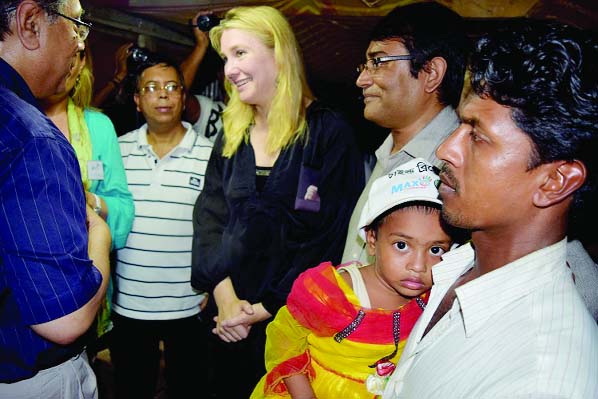
Patuakhali Correspondent :’There was no tube-well in the area. We had to fetch drinking water from two kilometers away-Basakbazar. Often, it being dark, people here had to drink water from arsenic-contaminated tube-wells. Those days are gone. Tube-well water is now not only being drunk but also used in household chores and diseases of the families have reduced as well,” said Hanufa Akter,35, a resident of Kalikapur union of the district. Echoing Hanufa, Rahima Begum,55, another beneficiary of tube-well, said Unnayan Shahojogy Team with the assistance of the Netherlands-based Max Foundation set up tube-wells in the area on November 27, 2014. Around 50 families are now taking benefit from the facilities. They use tube-well water in the vegetable gardens on their homesteads. Rahima added apart from tube-wells, Max Foundation has been carrying out different other service activities related to mother and child health, children’s birth registration and growth measurement, maternity health, water management and sanitation. This correspondent found the scenario during a recent visit to the Sidr, Aila and Manasen-battered Kalikapur, Jaintika, Morichbunia, Awliapur and Bhutumia area under Chotbighai union of sadar upazila.Local sources said alongside foods and clothes, the residents here face problems mainly in health, education, pure water and sanitation. Though the death rate of the under-five children has reduced in Bangladesh, the country will have to show more success in attaining the Millennium Development Goals (MDGs) by the year 2015. And people of different inaccessible areas affected by natural disasters lag behind in this respect. According to the Bangladesh Democratic and Health Survey (BDHS)-20014, the country’s maternal mortality rate and child mortality rate have come down to 60 per cent and 50 per cent respectively in the last 15 years. In 1990, 574 women in one lakh died during child delivery, but the figure is now 170 only. The Bangladesh government has a target to bring down the number to 143 by the year 2015. Besides, a plan has been taken to reduce death rate of the children under five to 31 in every 1,000 by the year 2015. Survey shows that mortality rate of the under-five children has come down to 46 per cent and that of the under-one children has come down to 38 per cent. Yet one child in every 22 die before reaching the age of five. Because of development in nutrition, the number of underweight and undersize children has also reduced. The rate of undersize children has come down to 36 per cent while that of the underweight children has reduced to 33 per cent. Pregnant women’s four-time health services have increased double. So all receive health services from the trained, which has increased to 31 per cent from 17 per cent. But still three pregnant women in every 10 receive treatment at least four times following advice.Survey report says there has been increase in skilled delivery services. The present rate of delivery services with the assistance of nurses is 16 to 41 per cent. Four deliveries in every 10 are being performed with the help of trained nurses. Kohinur Begum, 30, of Bollobpur village under Kalikapur union, said the local residents are now very much safe from various diseases due to various health awareness programmes of UST in association with Max Foundation.Sathi Begum, 32, and Helena Begum,36, of the same village said they are solving various problems themselves in groups with the assistance of the project workers. They are now well aware about different health problems and resistance of early marriage. Shah Mohammad Anwar Kamal, Executive Director of UST, said the major concerns in the area after Sidr, Aila and Mahasen were scarcity of pure drinking water, mother and child health and sanitation.

